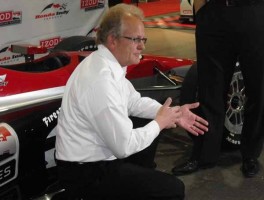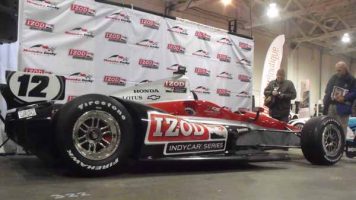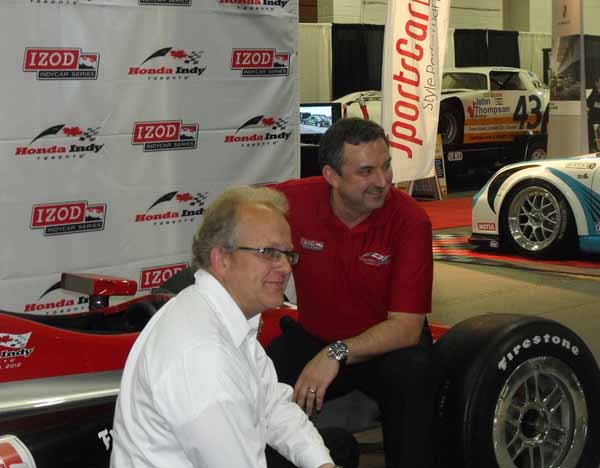 [/media-credit]
[/media-credit]
- Trevor Knowles, IndyCar Director of Engine Development
On Friday February 10th, IZOD IndyCar Director of Engine Development Trevor Knowles unveiled the brand new 2012 Dallara DW12 IndyCar for the first time in Canada as part of the Canadian Motorsports Expo at the International Centre.
The car includes many safety features to make the IndyCar Series safer after the death of Dan Wheldon at Las Vegas last October. Ironically, Wheldon had been helping series officials throughout 2011 develop this car, so therefore the car was named DW12 after Wheldon.
Some of the safety features and other changes include…..
The fenders are wider in the back to therefore prevent wheel-to-wheel locking, which was one of the contributors in Wheldon’s crash.
The drivers’ cockpit has changed as it’s wider to give the driver’s more room and sits them lower so they have more protection. Knowles also added that there is more padding with the new seats, saying, “As you remember, Justin Wilson hurt his back last year after going over a car. That wouldn’t had happened in this car.”
The series will run spec cars, which means “the teams have to run the cars as delivered by Dallara”. Knowles says they did this to therefore keep costs down, adding that this chassis is cheaper than the 2011 chassis. He went on to say that the same suspension will be used on road courses and speedways. The gearbox is also supplied to the teams.
They switched from steel to carbon brakes, which once again reduce the costs because the brakes last longer.
There is no clutch button in the car as it powered by a lever on the steering wheel now. Knowles added, “Hopefully that will keep the car running and reduced the number of full course yellows during practice or a race.”
There are three engine manufactures on board – Chevrolet, Lotus and Honda. In past recent seasons, Honda has been the sole supplier of motors. The engines are going to be a 2.2 V6 turbo charged with a spec minimum weight. Knowles says that IndyCar does have control over certain individual specs of the motors, too, and changes may come during the season as they are needed. These motors will be controlled by ECUs, which will be supplied by IndyCar. It controls gear shifts and clutch, along with setting in an RPM limit. Manufactures will be allowed to change calibrations, but nothing beyond that as Knowles says that stops the usage of traction control and other tricks.
Also, IndyCar will be incharge of how the manufactures supply the engines. Knowles spoke of how sometimes manufactures pick and choose certain people to get certain engines to therefore have some cars stronger. This will not happen as manufactures must send the motors to IndyCar first, and then IndyCar will send them out to the teams.
Teams will only need up to eight motors a year and IndyCar will be keeping track of this. Approved engine changes will be allowed – such as when a motor reaches its life or has blown up. Unapproved changes are also allowed, but the team will be penalized for that. Also, once the motor is put in the car, it will be sealed as officials don’t want them making changes once at the shop.
They’ve also switched the fuel from ethanol to Sonoco’s racing fuel and switched to direct injection, which makes it easier for the manufactures in development.
The Turbo Chargers are also supplied by one company to the manufactures to keep things even across the board. Manufactures had the choice between a single turbo charge or a twin turbo charger. Honda chose single while both Chevrolet and Lotus chose twin.
They will also run torque sensors on select cars each week to therefore determine the varying performance levels. If a manufactures performance is significantly lower than that of their rivals, they will be allowed to make changes. Knowles says, “We don’t wanna punish a manufacture for running good, but we wanna keep all manufactures competitive.”
IndyCar will begin the season without the overtake switch and whether or not it is implemented will depend on how the racing looks. If they
[media-credit id=4 align=”alignright” width=”356″] [/media-credit]choose to implement it, it will have a different set-up than they’ve had before. The old system it would initialize the overtake right away, while the new system would have a slight delay before kicking in.
[/media-credit]choose to implement it, it will have a different set-up than they’ve had before. The old system it would initialize the overtake right away, while the new system would have a slight delay before kicking in.
Engine recovery system is also not included on this car, but may be included down the road. This is part of trying to save the teams money right now.
With regards to suspension and handling, teams will have an option to run a combination of the old style with the new style. The new style suspension pushes more weight towards the front of the car. By allowing this, it allows the teams to have some innovation on their side to some weeks some will get it right and other weeks they won’t get it right.
A lot of people are excited for what the 2012 season has to bring for the IZOD IndyCar Series as it should be exciting with the changes have taken place and what it is to come.
The 2012 season begins with St. Petersburg on March 25th. For more information on the IZOD IndyCar Series, check out http://www.indycar.com.








